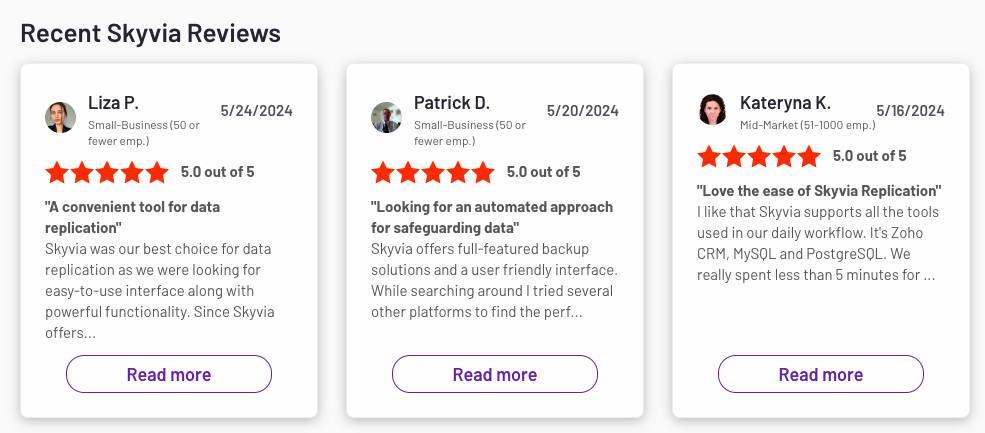Salesforce is a mega-popular CRM due to its high degree of customizability, which makes it suitable for complementing customer records with specific details. But how do you avoid getting lost in the ocean of customer data?
You need a Salesforce query tool to get the necessary information quickly.
Such tools help you extract Salesforce data based on specific criteria. For instance, you might need a list of clients who haven’t made any purchases in the last six months and send a promotional email to them.
Or, you’d like to find all Accounts with no associated Contacts with addresses. A Salesforce query tool can also help you calculate an average deal size for clients from the selected industry.
In fact, Salesforce query tools carry out many other significant functions that organizations can benefit from. This article lists efficient solutions for querying Salesforce data and explains their functionality in detail.
Table of Contents
- Understanding Salesforce Query Tools
- Top 5 Salesforce Query Tools in 2026
- Finding the Right Salesforce Query Tool for Your Requirements
- Salesforce Query Tools: Final Thoughts
Understanding Salesforce Query Tools
What is a Salesforce Query Tool?
A Salesforce query tool is usually a standalone software application designed for data query and export. However, it can also be a part of another, more sophisticated platform. For instance, Workbench for Salesforce has a query module along with metadata management and API exploring features. Another embedded solution example is Skyvia Query, which is a part of the data management platform.
Depending on the tool, SQL or SOQL query language is used to interact with Salesforce data. SOQL is a native Salesforce query API, primarily designed to work with Salesforce data.
A commonly used SOQL query is similar to the following structure:
SELECT list_of_fields [subquery]
FROM object_name
[WHERE condition_expression]
[GROUP BY list_of_fields]
[HAVING condition_expression]
[ORDER BY list_of_fields {ASC|DESC} [NULLS {FIRST|LAST}] ]
[LIMIT count_of_rows_to_return]
[OFFSET count_of_rows_to_ignore]SOQL allows you to create an advanced query with joins, conditions using LIKE, etc.
Modern Salesforce query tools also provide visual Salesforce query builders, where you can manually drag and drop Salesforce fields and specify filtering options. The query results are available for viewing and downloading.
Why You Need Salesforce Query Tools
Data stored in Salesforce doesn’t bring much value when standing still. It’s not enough just to accumulate more and more information about customers. Data needs to work for you and reveal insights for your business development.
Querying Salesforce data helps to extract value from it in the following ways:
- Perform complex reporting and analysis.
- Take advantage of filtering capabilities that go beyond standard ones in Salesforce.
- Explore relationships between your data.
- Get an overview of data from the different objects’ perspectives.
- Ensure enhanced data management.
- Ask questions and get exact answers to them.
- What types of customers buy your products?
- Where are most of your clients located?
- What is the best-performing source for bringing new leads?
- How much money was earned over a certain period of time?
For instance, you can search for the list of clients based on a certain criterion indicated in the WHERE statement.
UPDATE Contact
SET FirstName = 'John'
WHERE CustomerCity = ‘Buenos Aires’You can also use query tools to group Salesforce records, order them, and perform a range of other operations on data. Obviously, such solutions provide a number of benefits:
- Efficiency. Queries save much time in gathering the required information and enhance your data-related workflows.
- Accuracy. The Salesforce query tools allow you to specify filters, increasing search results’ accuracy and precision.
- Clear vision. Formulate specific queries related to your customers, leads, or deals and analyze the obtained query results.
Top 5 Salesforce Query Tools in 2026
We are here to reveal effective tools for querying Salesforce data. Some rely on standard SQL language, which is widespread in the tech world. Others rely on SOQL, which is typical within Salesforce-centered environments.
Tool 1: Skyvia
Skyvia isn’t just a collection of features; it’s a CRM database query builder designed to help teams explore Salesforce data without touching SOQL. Instead of wrestling with syntax or pulling reports one by one, Skyvia lets you dig into accounts, opportunities, contacts, and any custom object using a clean, visual interface.
A Powerful Tool for Sales Data Analysis
Skyvia Query is built for people who want answers fast. It turns Salesforce into an on-demand analytics workspace where you can build targeted queries to understand what’s driving performance across the pipeline.
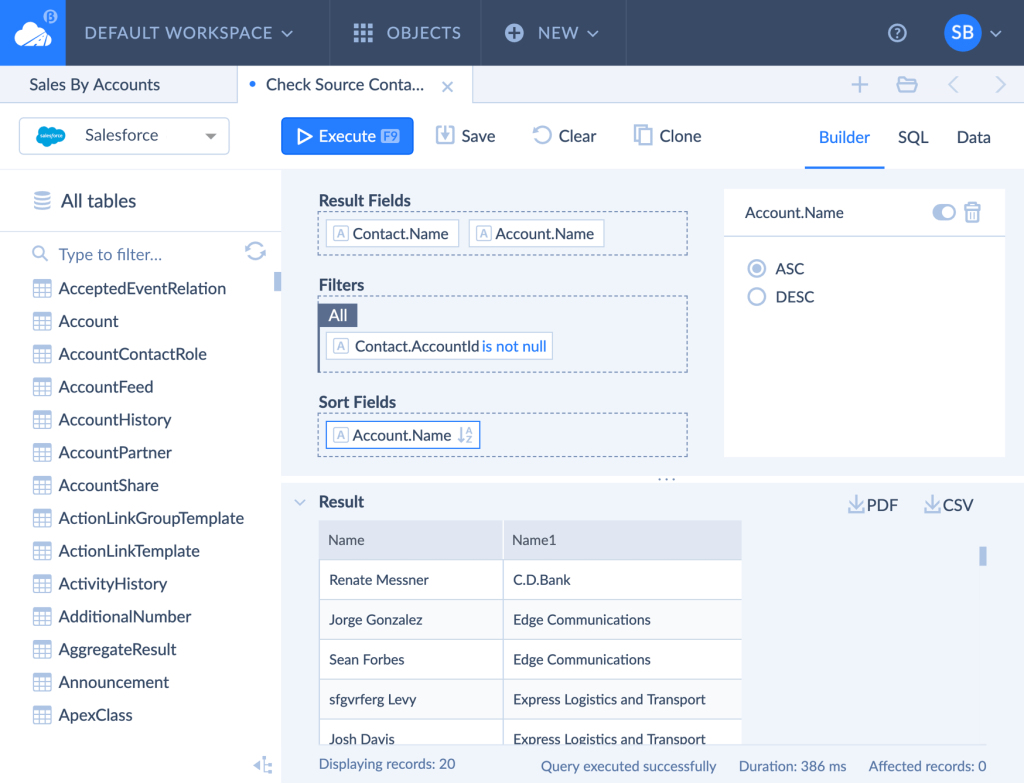
Here’s what that looks like in practice:
Sales performance by account
- Choose Account as your base object, add fields like Annual Revenue or Industry, and apply filters to highlight high-value customers or accounts with declining activity. Group and sort results to see which accounts are consistently contributing to the pipeline or revenue.
Regional sales insights
- Pull in territory fields such as Billing Country, Billing State, or your custom region taxonomy. With a few clicks, compare how different regions perform, identify strong markets, or spot territories where conversion is lagging.
Contact-level engagement tracking
Start with Contact, join Opportunities or Cases, and surface patterns like engaged buyers, stuck deals, or accounts with stalled communication. This makes Skyvia especially handy for account and contact management workflows. Skyvia Query tool allows users to:
| Pros | Cons |
|---|---|
| 1. Visual query editor 2. SQL language support 3. Results are available for download in CSV or PDF 4. Query Salesforce data directly in Excel or Google Sheets | 1. Only up to 5 queries per day are available for free |
Skyvia handles the relationships and joins behind the scenes. You simply drag objects into the builder, pick the fields you need, apply your filters, and run the query. Salesforce returns fresh data each time you execute it, no scripts, no API calls to write, no real-time sync to configure.
As one of the most user-friendly sales data analysis tools, Skyvia also lets you export results to Excel, Google Sheets, or BI tools so you can continue analysis or share findings with the team.
Given that Skyvia is a universal cloud data platform, you can also perform a range of other data-related tasks, such as:
- Enrich Salesforce data by integrating additional details about clients from datasets or other tools.
- Backup Salesforce data to ensure its integrity.
- Send your Salesforce data to a data warehouse and combine it with data from other tools to perform advanced analytics.
See what people say about Skyvia:
When to Use Best
Skyvia Query is the best for database professionals who know SQL but don’t know Salesforce SOQL. It is also suitable for people that know neither of the languages with its visual query builder. It’s a great tool when you need to quickly create a small report and view it in a browser or export a larger report to a CSV file.
Additionally, Skyvia Query is great for performing mass updates or deletes using SQL DML statements. Skyvia does not require specifying Salesforce IDs for mass updates; you can specify SQL WHERE conditions to select records for updating or deleting.
The third optimal scenario is querying Salesforce data directly from Excel or Google Sheets via the corresponding add-ons.
Tool 2: Salesforce Developer Console
The Salesforce Developer Console is Salesforce’s built-in environment for developers, and its Query Editor is one of the simplest ways to run direct SOQL queries inside your browser. It’s handy for quick Salesforce data retrieval, especially if you’re already comfortable writing SOQL by hand.
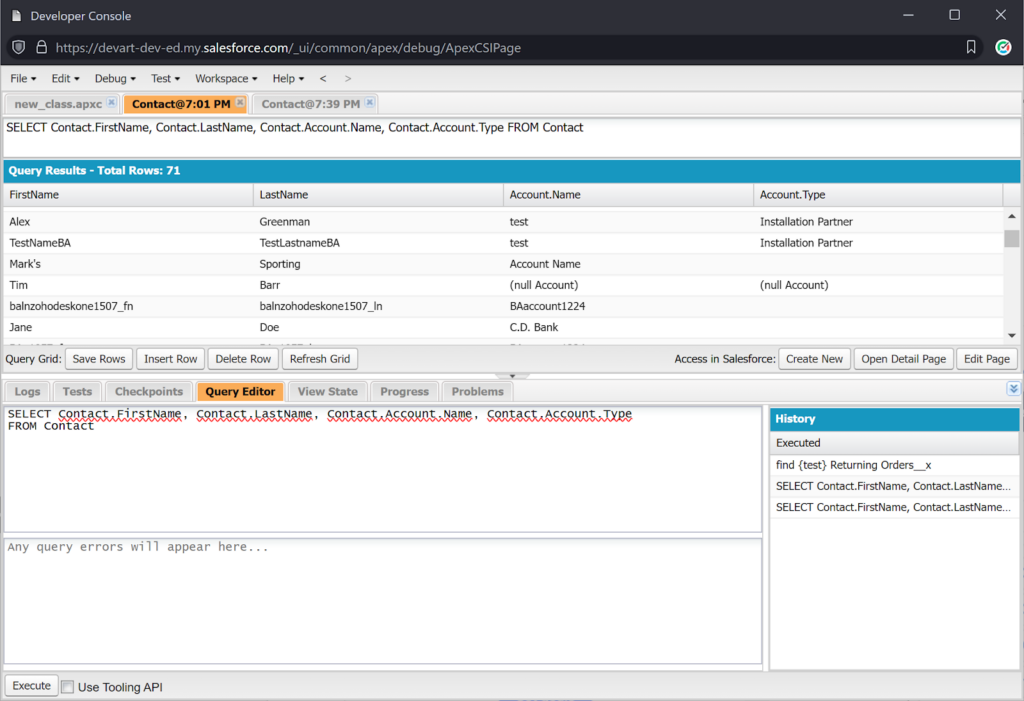
A typical example looks exactly like what’s shown in the image. Something like:
SELECT Contact.FirstName, Contact.LastName FROM Contact You run the query, and the results appear immediately in the console under the results grid.
This setup works well for developers who know the syntax and just need to test queries, inspect Salesforce contact information, or troubleshoot relationships between objects.
But for business users, the Developer Console hits its limits pretty fast. There’s no visual query builder, no drag-and-drop filtering, and no easy way to sort or segment things like Salesforce account types. Exporting Salesforce query results requires extra steps, and you’ll need to understand object relationships before you can even begin writing a query.
| Pros | Cons |
|---|---|
| 1. Native Salesforce solution, always available 2. Allows viewing and editing data in the browser 3. Supports SOSL4. Free | 1. Requires knowledge of SOQL or SOSL 2. Has no visual query configuration |
When to Use Best
Salesforce Developer Console requires SOQL and/or SOSL knowledge. It is useful when you want not only to execute queries against Salesforce but also to immediately edit their results. Note that you need to include record IDs to query in order to edit data.
This tool also does not provide the means to export results to a CSV file, so it won’t suit generating CSV reports.
It’s a solid solution for technical users, but most teams will get far more value (and far less friction) from a dedicated, user-friendly Salesforce query tool that handles the structure, mapping, and filtering. vide the means to export results to a CSV file, so it won’t suit for generating CSV reports.
Tool 3: SOQL (Salesforce Object Query Language) Builder
SOQL Builder is a tool from the Salesforce Extension Pack. Developers and administrators use this service to build queries in the visual editor. The query results can be saved in a CSV or JSON file.
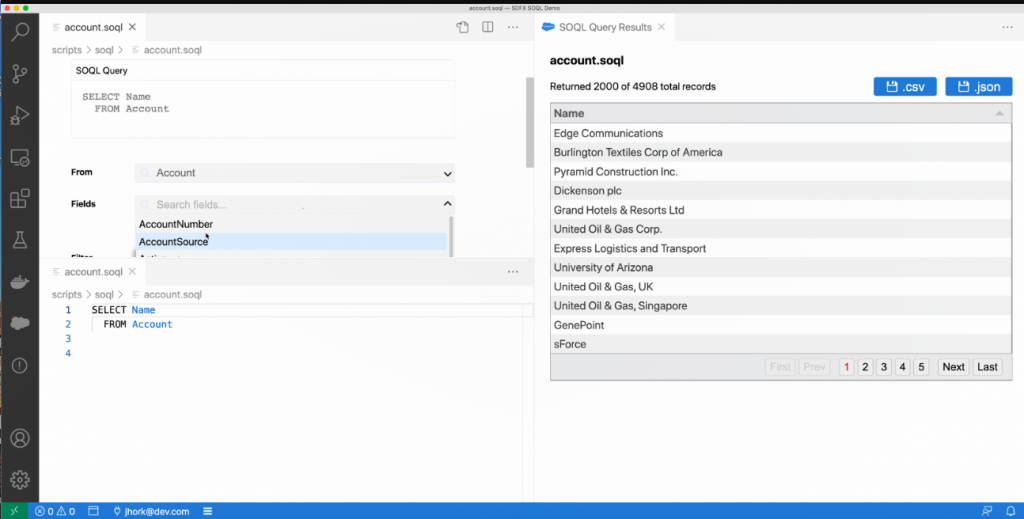
| Pros | Cons |
|---|---|
| 1. Native Salesforce solution 2. Visual query editor 3. Query results can be downloaded | 1. Requires knowledge of SOQL 2. It’s possible to retrieve a maximum of 2000 records for one SOQL query |
When to Use Best
SOQL Builder is intended more for developers, as it is a part of Visual Studio Code add-on. People with or without SOQL knowledge can use it, as it allows visual query configuration, but only for simpler single-object queries.
You can use it to create short CSV reports of up to 2000 records because of the tool’s limitations.
Tool 4: Workbench
Workbench is a web-based Salesforce query tool suitable for administrators, developers, and business analysts. It’s also a popular solution for exploring the Salesforce metadata, resetting user passwords in the organizational account, and working with Force.com APIs.
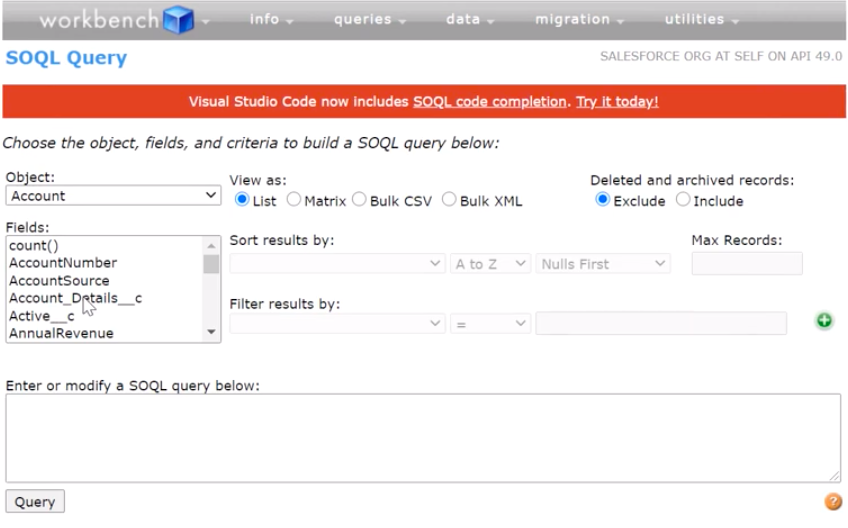
Workbench uses SOQL query language, which is similar to standard SQL but with some limitations on the SELECT statement. It’s also possible to perform queries in the visual builder using filtering and sorting parameters.
| Pros | Cons |
|---|---|
| 1. Has a number of additional functions 2. Free 3. Visual query builder | 1. The latest version of this service might work unstable |
When to Use Best
People with and without SOQL knowledge can use Workbench. It can present results in the browser and export them to CSV and XML. While most tools described here can export to CSV, Workbench can be especially useful when you need to export your reports to XML.
Additionally, Workbench can be used to modify data. It can perform single record updates/deletes or mass updates/deletes, but you must specify the corresponding data in a CSV file.
Workbench can also be used to import data from CSV files.
Tool 5: Data Loader
Salesforce Data Loader is a Windows OS desktop application available for download on the official Salesforce online portals. It’s designed by Salesforce to help users create, update, and delete records in bulk with a visual wizard instead of SOQL queries.
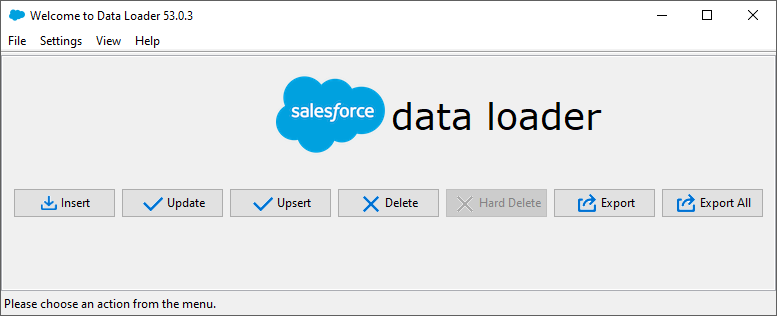
Salesforce Data Loader allows you to select specific data and download it via visual wizard. Just click the Export button, select the Salesforce object and fields, apply filters if needed, and there you go!
| Pros | Cons |
|---|---|
| 1. Salesforce native solution 2. Has a visual query builder 3. Free | 1. Available only for Windows users |
When to Use Best
You can use Salesforce Data Loader if you want to use a locally installed solution instead of a cloud one. This tool is more oriented for importing and exporting CSV files to and from Salesforce objects, but it allows exporting results of a custom query.
Salesforce Data Loader allows you to configure query visually, so SOQL knowledge is not required. But if you are a SOQL professional, you can edit the configured query.
Finding the Right Salesforce Query Tool for Your Requirements
Let’s look at the table below to help you decide which Salesforce query tool would suit you best.
| Query language | Query builder | Parameter | |
|---|---|---|---|
| Skyvia | SQL | Yes | In PDF or CSV files. Additionally, it’s possible to query Salesforce data directly in Google Sheets and Excel. |
| Salesforce Developer Console | SOQL, SOSL | No | text, XML, JavaScript, or CSS |
| SOQL Builder | SOQL | Yes | CSV or JSON file |
| Workbench | SOQL | Yes | CSV or XML file |
| Data Loader | No querying | Yes | CSV file |
In fact, SOQL Builder and Workbench can perform specific queries to extract the data of interest. All the requests are made using SOQL language. If you know the specifics of this query language, these tools might be a good choice.
Data Loader isn’t a standard query tool, though it allows users to select Salesforce data via visual builder, apply filtering, and export it in a CSV file. This tool is convenient to use, though it’s suitable only for Windows computers.
Skyvia combines most of the features and advantages of the above-mentioned tools and adds other valuable ones. You can construct queries in a visual builder not only for Salesforce data but also for other popular apps and databases. At the same time, Skyvia can enrich Salesforce data with additional details about your clients, back it up, and integrate it with other sources.
Salesforce Query Tools: Final Thoughts
Building and maintaining customer relationships is crucial for any business. Salesforce query tools are among those solutions that help companies manage and improve their understanding of target audiences, sales lifecycles, and other aspects.
Skyvia allows you not only to query Salesforce data but also to perform a range of other operations on it. In fact, Skyvia is an all-in-one platform suitable for multiple data-related operations. You can try all that now with the free version of Skyvia and upgrade later at any time.

